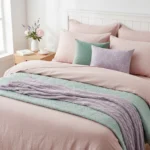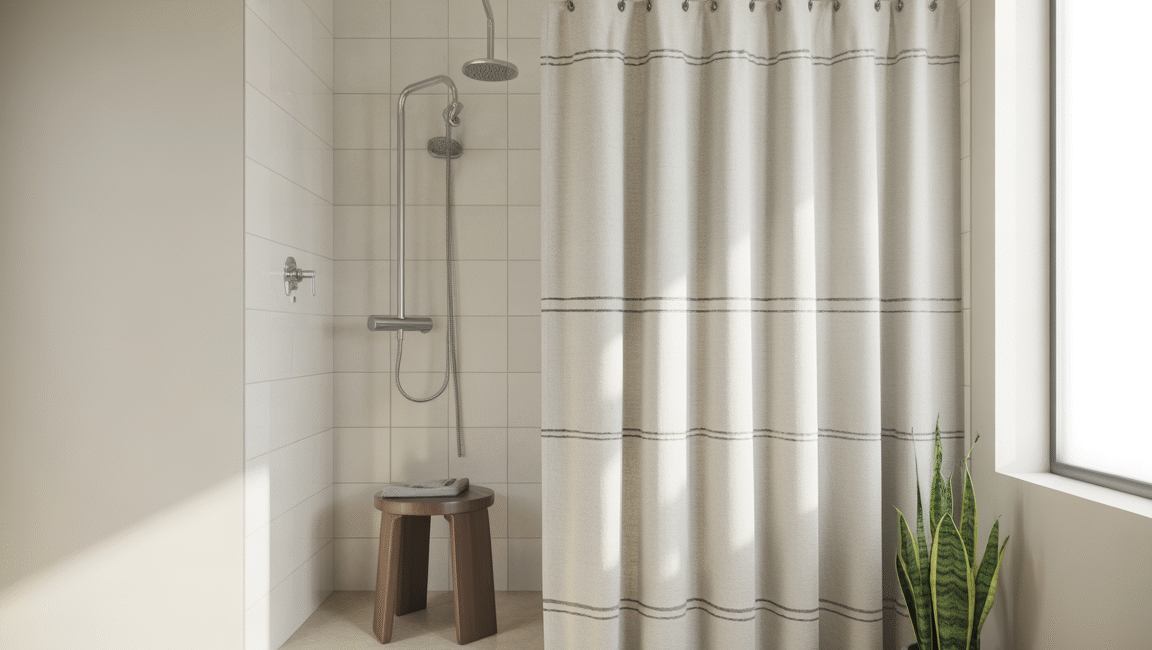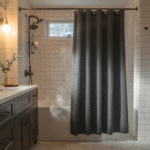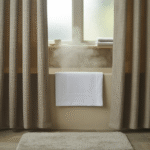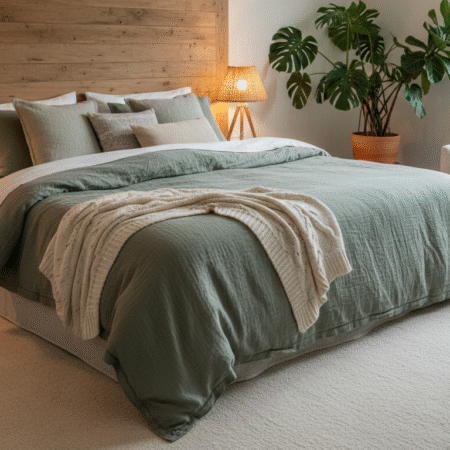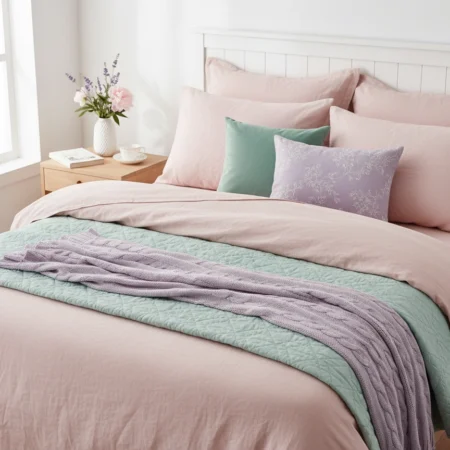If you’re staring at a small bathroom and a big quote for a glass shower door, you’re not alone. A well-done shower curtain can look clean, last years, and make a tight bathroom feel bigger—for a fraction of the cost. The trick is doing it intentionally, not as an afterthought.
Below are seven field-tested hacks I share with friends and clients when they want a budget-friendly, space-saving upgrade without a glass door. You’ll get specific measurements, materials that actually hold up, and layout tips that prevent common annoyances (like liners clinging to your legs or water escaping).
1) Use the Right Rod Shape for Your Space (and Gains You Actually Feel)
Most people buy a straight tension rod by default. It works, but you can steal meaningful elbow room (and make a small bathroom feel bigger) by choosing the rod shape based on your layout.
What to know
- Straight rod: Clean, minimal, best for very tight bathrooms where you don’t want anything projecting outward.
- Best for: Walk-in showers with limited aisle space, narrow rooms.
- Pro tip: Choose a fixed-mount rod (screwed to the wall) for heavier fabric curtains. Tension rods can sag over time.
- Curved rod: Bows outward 6–9 inches, which adds elbow space inside without touching you.
- Best for: Tubs or showers where there’s enough room between tub edge and vanity/toilet.
- Measure first: You need at least 8–10 inches of clearance from the tub edge to nearby fixtures.
- L-shaped or Neo-angle rod: For corner showers.
- Best for: Tight, odd layouts or converted alcoves.
- Tip: Choose models that include ceiling support—that stabilizing post makes a huge difference.
- Ceiling-track rail: Looks high-end, glides effortlessly, perfect for curbless showers.
- Best for: Minimalist or accessible bathrooms.
- Note: Requires drilling into the ceiling; check what’s above (concrete slab vs. joists).
Quick sizing
- Rod length = finished wall-to-wall distance minus 1/4″ to 1/2″ for fixed rods (follow the manufacturer).
- For tension rods, buy a model whose midpoint covers your span (e.g., for 54–90″ adjustable, a 72″ span sits near the middle—more stable).
Key takeaway: Pick the rod for the room you have, not the room you wish you had. Curved and ceiling tracks can feel like +10% more space inside the shower.
2) Go Taller: Ceiling-Height Curtains Keep Water In and Make the Room Look Bigger
Standard curtains are 72″ long because… that’s what’s on the shelf. But raising the rod and using a longer curtain visually lifts the room and reduces splash.
How high is high?
- Ideal finished height is 1–2 inches below the ceiling (or bottom of crown molding) for the rod/track.
- Curtain drop: bottom edge should hang just above the tub rim (¼”–½”) or ½” above the floor for walk-ins.
Sourcing taller curtains
- Look for 84″, 90″, or 96″ length curtains. Many “window” drapery panels (treated or lined) are washable and work beautifully when paired with a proper vinyl or PEVA liner.
- Or buy a custom-length shower curtain online; it’s usually cheaper than you think.
Don’t skip the liner
- Use a weighted, mildew-resistant liner cut to the same width and slightly longer than the curtain. The liner hangs inside the tub/pan; the curtain hangs outside.
- Liners: 72×72″ is standard, but 72×78″ or 72×84″ keeps water in for tall rods.
Key takeaway: A higher rod + longer curtain = fewer leaks and a visually taller room without moving a single wall.
3) Choose Fabric Like You’d Choose a Sofa: Durable, Washable, Mold-Resistant
Curtains live in steam, soap scum, and hard-water spray. The right materials handle that abuse without looking tired after a month.
Curtain fabric options
- Polyester (or polyester blends): Workhorse. Colorfast, drapes nicely, easy to wash.
- Cotton with a tight weave: Natural look, but always use a liner; it absorbs water. Wash monthly.
- Nylon or microfiber: Fast-drying, good for high-use showers.
- Outdoor-rated fabrics: Surprisingly great for bathrooms; they resist UV and mildew.
Liner choices
- PEVA or EVA: Chlorine-free, low odor, flexible.
- Vinyl (PVC): Very common; choose low-odor and weighted hem.
- Fabric liners (polyester with waterproof coating): Washable and more durable, cost slightly more but last longer.
Hardware that lasts
- Hooks/rings: Stainless steel or brass. Plastic clips can yellow and snap.
- Rod finish: Brushed nickel, chrome, or powder-coated finishes resist rust. Avoid bare steel.
Care routine (fast & simple)
- Weekly: After showering, stretch curtain open to dry.
- Monthly: Toss curtain and fabric liner in the wash (cold, gentle) with 1 cup white vinegar, hang to dry.
- Quarterly: Wipe rod and rings with a vinegar/water mix.
Key takeaway: Pick washable fabrics and rust-proof hardware so your “cheap” solution doesn’t become a monthly replacement plan.
4) Stop the Cling and the Leaks: Weight, Width, and Airflow Tricks
Most complaints about shower curtains trace back to physics: airflow and water paths. Fix those, and the curtain behaves.
Stop “curtain cling”
- Use a weighted liner with at least 2–4 oz weights in the hem.
- Install two small binder clips or magnetic clips near the bottom corners to add a little extra pull.
- Keep the bathroom fan running and leave a 1–2″ gap between liner and curtain to let moisture escape.
Seal the ends
- Install end splash guards (small L-shaped acrylic pieces) where the tub meets the wall—these cost a few dollars and block water from sneaking behind the curtain.
- For walk-ins, use a short silicone water dam along the threshold and ensure the curtain overlaps it by an inch.
Get the width right
- Curtain width should be 1.5–2x the rod span for proper overlap and drape.
- Example: For a 60″ tub, aim for 90–120″ of total curtain width (two panels often look better than one).
Double-rod setup (game-changer)
- Use a double rod: liner on the inside rod, decorative curtain on the outside.
- Benefits: Easy liner replacement, better airflow, and you can hide storage (see Hack 7).
Key takeaway: Weighted, wide enough, and sealed at the ends = a curtain that behaves like a door without the price tag.
5) Make It Look Designed, Not Temporary: Layering, Alignments, and Color
A curtain can absolutely look intentional—sometimes better than a smudged glass door—if you treat it like a design element.
Layering that feels upscale
- Double rod + fabric curtain + weighted liner.
- Add uniform metal hooks for a clean rhythm across the top.
- Consider Euro pleat clips on fabric curtains for a drapery look (works best with fixed rods).
Color and pattern
- Small bathrooms: Light solids or small-scale patterns keep the room feeling open.
- Tall rooms: Vertical stripes emphasize height.
- Rental refresh: A bold print can become the room’s focal point, saving you from repainting.
Align with tile lines
- If your shower tile has a strong horizontal line (like a contrasting border), place the rod so the curtain echoes that line—it feels intentional.
Tie-backs? Use sparingly
- In very small baths, a simple hook on the wall works when you want light in the shower area. Avoid bulky tie-backs that can get damp.
Key takeaway: Treat the curtain like a real design decision—layer it, align it, and let it carry the room.
6) Spend Smart: Where to Save and Where to Invest (Typical Costs)
Switching from a glass door to a curtain is where budgets breathe. Here’s how to allocate dollars so the setup lasts and looks good.
Typical price ranges (USD)
- Rod: $15–$40 (tension), $35–$120 (fixed/curved), $80–$200 (ceiling track with hardware).
- Curtain: $20–$60 (standard), $60–$150 (extra-long/custom).
- Liner: $10–$30 (PEVA/vinyl), $20–$40 (fabric waterproof).
- Hooks/Rings: $8–$25 (stainless/brass).
- Splash Guards/Threshold Dam: $10–$25.
- Ceiling support (for L or long runs): $15–$35.
Where to save
- Use a tension rod if you can’t drill (rental), but pick a sturdy one with rubberized ends and keep the span near its midpoint.
- Buy a budget decorative curtain and pair it with a quality liner—the liner does most of the waterproofing.
Where to invest
- Rod and hooks: Cheap metals rust fast in steam. Stainless or brass pays off.
- Fabric liner if you hate replacing liners—it washes clean.
- Splash guards for tubs or water dams for walk-ins—small spend, big difference.
Return on investment
- A decent curtain setup often runs $80–$250 total, compared to $600–$1,500+ for many glass doors (before labor).
- Time saved: No squeegeeing glass daily, and replacements are quick.
Key takeaway: Spend on what touches water and metal; save on the decorative layer.
7) Make Your Curtain Do More: Storage, Light, and Accessibility
Once you have a stable, well-sealed curtain, you can ask it to work harder for your lifestyle.
Built-in storage (hidden and handy)
- With a double rod, hang a slim mesh organizer on the inside rod behind the curtain. It keeps bottles off the floor and out of sight.
- Use over-rod S-hooks to hang a quick-dry towel just inside the curtain—no door swing needed.
Let the light in
- Choose a curtain with a sheer top panel (sometimes called a “window” panel) to borrow light without sacrificing privacy.
- For dark showers, a clear or translucent liner brightens everything immediately.
Accessibility and safety
- Curtains are often safer than doors for mobility changes: no tracks to step over, no door to navigate.
- Add a weighted hem and ensure the bottom doesn’t drag—tripping hazard solved.
- Pair with grab bars and a non-slip mat for a safer, senior-friendly setup.
Quick swapping for cleaning or guests
- Keep a backup washed liner folded in the vanity. Swapping takes 60 seconds.
- For guest baths, use fresh white curtains—they read clean and hotel-bright.
Key takeaway: Use the curtain’s flexibility—store smarter, brighten the space, and keep it accessible.
Planning & Measurement Cheatsheet (Because Guessing = Leaks)
Quick measurements before you shop
- Width (rod span): Wall to wall above the tile.
- Height (rod placement): Aim for 1–2″ below ceiling, confirm the curtain will finish ¼–½” above tub rim or ½” above floor.
- Clearances:
- If using a curved rod, ensure ≥8–10″ from tub edge to the nearest obstruction.
- For ceiling tracks, verify ceiling type (wood joists vs. concrete).
- Curtain width: 1.5–2x rod span total.
- Liner length: Usually equal to or 1–2″ longer than curtain for better splash control.
- Hook count: Most curtains have 12 grommets; some extra-wide curtains have 16—check your rod rings.
Troubleshooting: Fast Fixes for Common Problems
- Water escaping at the ends
- Add tub splash guards, ensure liner touches the inside of the tub lip, and angle the showerhead away from that side.
- Rod slipping (tension type)
- Clean wall tiles with alcohol, rotate the rod so the extension seam faces up, and consider adhesive rod mounts.
- Rusty hooks
- Replace with stainless steel ball-bearing hooks; they glide smoothly and don’t squeak.
- Mildew smell
- Wash on gentle with vinegar + baking soda, fully dry open, run the exhaust fan during and 20 minutes after showers.
Mini Guide: Tub vs. Walk-In Shower Curtain Setup
For a tub/shower combo
- Rod height: High as possible while keeping curtain ¼–½” above tub rim.
- Must-do: End splash guards and a weighted liner.
- Nice-to-have: Curved rod if you have aisle space.
For a walk-in shower (with curb or curbless)
- Rod or track: Consider a ceiling track for a clean look and better containment.
- Threshold: Install a low water dam (silicone) if curbless; overlap it with the liner 1 inch.
- Floor slope: Ensure water drains away from the curtain; if not, extend the liner length slightly.
Shower Curtain Planner & Cost Saver
What it does:
- Recommends rod type based on your layout and clearances
- Calculates curtain length and liner length based on ceiling height
- Suggests curtain width and hook count
- Estimates cost using typical price ranges (you can tweak them in the UI)
Shower Curtain Planner & Cost Saver
Pick the right rod, curtain size, and liner. Get an instant cost estimate and practical notes.
Inputs
Results
Quick Start: A One-Trip Shopping List (Adjust to Your Measurements)
- Rod (curved, straight, or ceiling track) sized to your span
- Double rod optional (recommended for flexibility)
- Extra-long curtain (84″, 90″, or 96″ depending on ceiling)
- Weighted liner (preferably fabric or heavy PEVA, matching length)
- Stainless hooks/rings (12 or 24)
- End splash guards (for tub) or low water dam (for curbless)
- White vinegar (cleaning), microfiber cloth, adhesive rod mounts (for tile)
Small Choice, Big Impact
Going with a shower curtain instead of a door isn’t settling—it’s choosing flexibility, lower maintenance, and better space management. When you select the right rod style, hang the curtain higher, use a proper liner, and seal the ends, you’ll get a bathroom that looks bigger, works better, and costs less to install and maintain.
Take one small action today: measure your wall-to-wall span and ceiling height, then run them through the planner above. In ten minutes, you’ll know exactly what to buy and what it’ll cost. That’s all you need to turn a “temporary” fix into a bath that feels finished. You’ve got this.


